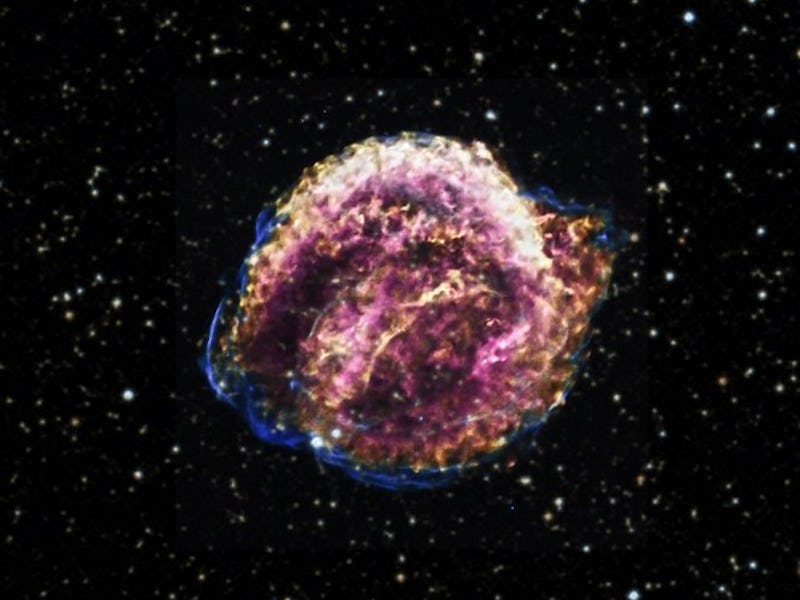Traces of million-year-old supernova found in Earth's deep sea
The remnants of this stellar explosion likely made it to Earth in the past 33,000 years.

As a star nears the end of its life, it runs out of fuel and collapses under the weight of its own gravity. The tremendous disintegration of the giant stellar being happens so quickly that it results in an extremely bright, powerful explosion known as a supernova.
Supernovae occur throughout the universe, and the material ejected by a star's explosive death spreads across the cosmos in a fiery flame.
Now, a team of astronomers from the Australian National University have discovered traces of an ancient supernova here on Earth, buried deep underwater in the Indian Ocean after traveling to Earth some 33,000 years ago.
The discovery is detailed in a study published Monday in the Proceedings of the National Academy of Sciences.
As a star explodes in a fiery death, material from the supernova erupts into space.
Stars are the main source of the different chemical elements found in the universe. Almost all of the elements that we know of were at some point created during the life and death of a star. Stars burn by producing helium from the hydrogen found in their cores; they then create heavier elements later in their life cycle, through a process known as nuclear burning.
When a star explodes, all of its material erupts into surrounding space. The cataclysm essentially shapes the interstellar medium, or the matter found in the space between different star systems in a given galaxy.
Some of that material may travel through our own Solar System, and the Solar System itself often passes through clouds of such interstellar material. As it passes, some of that same material could make its way on to Earth, leaving an imprint on the planet's geological record.
The researchers behind the new study found traces of radioactive iron isotopes in five sediment samples collected from the depths of the Indian Ocean. The iron isotope, known as 60Fe, is produced in stars and ejected into interstellar medium during a supernova explosion. This iron isotope is only found in cosmic rays and is not naturally produced on Earth.
Their presence in the sediments indicate that they likely traveled to Earth following a supernova explosion, the astronomers say.
The iron was deposited on Earth at a rate of 3.5 atoms per square centimeter per year over the past 33,000 years, according to the study. This slow rate of deposition over a long period of time indicates that the supernova spread the iron isotopes throughout the interstellar medium.
The origin of the radioactive iron was likely a million-year-old supernova which spread dust particles that may still be floating through interstellar space today, the study argues.
The Local Interstellar Cloud (LIC) is the likeliest source for the iron, the study suggests The LIC is an interstellar cloud in the Milky Way galaxy that stretches roughly 30 light years across, and our Solar System has been moving through the LIC for thousands of years now. In fact, it is still in its midst.
The LIC would contain remnants from ancient supernovae, which would make their way to Earth as our Solar System moves through this giant interstellar bubble.
Further measurements are needed in order to build a better timeline of when exactly these isotopes made their way to Earth, and if they were in fact deposited by the LIC, the astronomers say.
Abstract: Nuclides synthesized in massive stars are ejected into space via stellar winds and supernova explosions. The solar system (SS) moves through the interstellar medium and collects these nucleosynthesis products. One such product is 60Fe, a radionuclide with a half-life of 2.6 My that is predominantly produced in massive stars and ejected in supernova explosions. Extraterrestrial 60Fe has been found on Earth, suggesting close-by supernova explosions ∼2 to 3 and ∼6 Ma. Here, we report on the detection of a continuous interstellar 60Fe influx on Earth over the past ∼33,000 y. This time period coincides with passage of our SS through such interstellar clouds, which have a significantly larger particle density compared to the local average interstellar medium embedding our SS for the past few million years. The interstellar 60Fe was extracted from five deep-sea sediment samples and accelerator mass spectrometry was used for single-atom counting. The low number of 19 detected atoms indicates a continued but low influx of interstellar 60Fe. The measured 60Fe time profile over the 33 ky, obtained with a time resolution of about ±9 ky, does not seem to reflect any large changes in the interstellar particle density during Earth’s passage through local interstellar clouds, which could be expected if the local cloud represented an isolated remnant of the most recent supernova ejecta that traversed the Earth ∼2 to 3 Ma. The identified 60Fe influx may signal a late echo of some million-year-old supernovae with the 60Fe-bearing dust particles still permeating the interstellar medium.
This article was originally published on